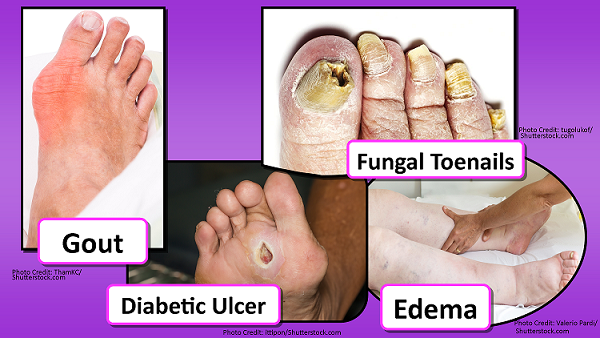This article will explain how to assess the upper and lower extremities as a nurse. This assessment is part of the nursing head-to-toe assessment you have to perform in nursing school and on the job.
During the extremity assessment you will be assessing the following structures:
- arms
- hands
- legs
- feet
Video Demonstration on Upper and Lower Extremity Assessment
Upper extremities:
Inspect arms and hands
- Deformities? (Heberden or Bouchard nodes as in osteoarthritis on fingers)

- Any wounds or IVs or central lines? (Assess for redness or drainage, expiration date etc.)
- Hand and fingernails for color: they should be pink and capillary refill should be less than 2 seconds
- Inspect joints for swelling or redness (rheumatoid arthritis or gout)
- Skin turgor (tenting)
Palpate joints (elbows, wrist, and hands) for redness and move the joints (note any decreased range of motion or crepitus)
Palpate skin temperature
Palpate radial artery BILATERALLY and grade it. If the patient receives dialysis and has an AV fistula, confirm it has a thrill present.
Have the patient extend their arms and move the arms against resistance and flex against resistance (grade strengthen 0-5) along with having the patient squeeze your fingers (note the grip).
Assess for arm drift by having the patient close their eyes and extend both arms for ten seconds. Note any drifting.
Lower extremities:
Inspect:
- color from legs to toes?
- normal hair growth? (peripheral vascular disease: leg may be hairless, shiny, thin)
- warm (good blood flow)?
- swelling (press down firmly over the tibia…does it pit?)
- any redness, swelling DVT (deep vein thrombosis)?
- capillary refill less than 2 seconds in toes?
- How do the toe nails look (fungal or normal)?
- Sores on the feet (Note: with diabetics, foot care is important. They don’t have good sensation on their feet. Therefore, inspect the feet for damage because they may not be aware of it.)
- Is there any breakdown on the heels?
- Assess joints of the toes and knees (any crepitus, redness, swelling, pain)

Palpate pulses bilaterally: popliteal (behind the knee), dorsalis pedis (top of foot), posterior tibial (at the ankle) and grade them
Palpate muscle strength: have patient push against resistance with feet and lift legs
Test Babinski reflex: curling toes is a negative normal response
More nursing skills